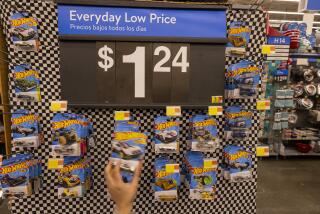Mobile Commerce Poised to Change the Way Americans Shop
- Share via
NEW YORK — Hand-held wireless devices will play an increasingly important role in retail in the near future, giving consumers another way to shop besides in stores, through catalogs and on the Internet, experts predicted last week during a national retail trade show.
By 2004, the number of mobile phones, personal digital assistants such as Palms and combinations of the two is expected to surpass the number of computers with Internet access, consultants with Accenture, formerly Andersen Consulting, said during a kickoff session at the National Retail Federation’s 90th annual convention at the Jacob Javits Convention Center.
Increasingly, consumers will rely on those devices to shop. That could mean everything from ordering a new big-screen TV scanned from an advertisement to locating the right size sweater when it’s out of stock in a store.
For now, “m-commerce,” or mobile commerce, is largely experimental among U.S. retailers and their customers, said Steven G. Skinner, a partner with Chicago-based Accenture. But that will change rapidly, he predicted.
Consumers in Japan and Europe, which have the telecommunications infrastructure in place, are far ahead of Americans with m-commerce, Skinner said. Scores of consumers, mainly young people, use the devices to send e-mail, chat on the phone and buy compact discs and books, he said.
Retailers such as Best Buy, Circle K convenience stores and Sears Canada either are using or experimenting with wireless devices, hoping to save time and money by having their employees do everything from receiving merchandise to helping customers in the store find products.
Another experiment is underway at the 200-store Palisades Center in New York, where retailers such as Gap Inc., Ann Taylor, Target, Home Depot and Victoria’s Secret alert shoppers to promotions via cellular phone. Barnes & Noble booksellers offer sample audio clips on hand-held devices.
In a test at nine of its restaurants, McDonald’s allows its customers to pay for Big Macs using mobile speed passwords, through cellular phones, without a phone call.
But putting the technology to use won’t happen overnight, said Jeff Luker, a managing partner for North America Retail East for Accenture. It will take time for customers to feel comfortable with the technology and for prices to fall.
Luker compared the current status of m-commerce to shopping on the Internet five years ago.
“When e-commerce was making its debut, there were a lot of skeptics,” Luker said. “The technology was cumbersome. Computers were expensive. Consumers were understandably dubious. They didn’t understand how the Internet worked and what to use it for.”
Skinner predicted that traditional retailers won’t let the purely Internet retailers get an edge in m-commerce the way some, such as Amazon.com, did with e-commerce. “This will be more of a race,” he said.
The expected growth in m-commerce reflects the need for retailers to deal with consumers who have less time and patience for shopping and more choices than ever, said Bruce Westbrook, a partner with Deloitte Consulting.
Deloitte expects that new technology--not necessarily through hand-held devices--will enable retailers to keep track of products a consumer usually buys.
“It is a different way to think about the shopping experience, and it can be applied to any type format, by understanding what people buy and why and taking action,” Westbrook said.
Some of the ideas sounded good but won’t work in practice, said Cathy David, general manager for store brand sites for Target Corp.’s Internet arm.
“The concept of marketing to an individual is attractive,” but doing so might prove too costly to keep a retailer viable and profitable and also might violate a customer’s privacy, David said.
More to Read
Inside the business of entertainment
The Wide Shot brings you news, analysis and insights on everything from streaming wars to production — and what it all means for the future.
You may occasionally receive promotional content from the Los Angeles Times.








